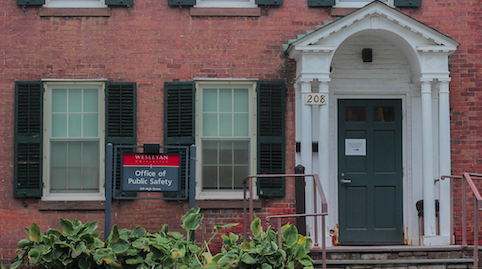Content Warning: This article contains reference to sexual violence, hate crime, and other violent crimes.

c/o Nathan Kolodney, Contributing Photographer
Public Safety (PSafe) recently released their annual Campus Security and Fire Safety Report, which includes statistics on crimes and fires on and around the University’s campus from 2017 to 2019. Notably, the report, which tracks every crime report received by PSafe, indicates a decrease in alcohol and drug crime violations over that three year span.
PSafe also tracks and monitors violent crimes, burglaries, thefts, hate crimes, and reports of sexual violence. In 2019, there were 15 reports of rape, eight burglaries, five instances of stalking, five instances of date violence, two assaults, one robbery, one car theft, and one student illegally in possession of a weapon. There were no reported homicides, hate crimes, domestic violence, or instances of arson in 2019.
According to PSafe’s data, reported alcohol violations have declined by 32% since 2017, dropping from 312 that year to 211 in 2019. Drug violations also dropped by 29%, going from 157 in 2017 to 111 last year. Despite this decrease, the vast majority of recorded crimes on and around campus are still drug and alcohol violations.
Director of Public Saftey Scott Rohde believes that these numbers are dropping because of a concerted effort by various organizations and groups on campus. He says some instances that may have been reported to PSafe in the past are now being handled by other authorities.
“In the last five years, a lot of efforts have been made in the area of education and working with, WesWell, the Counseling Center, Class Deans, PSafe, [and] Residential Life to do a lot of programming,” Rohde said. “Our goal is to try to bring these numbers down through education and handling things through informal means. So, in other words, if an RA became aware of a student that had an alcohol problem, a referral to the Health Center or an agency other than Psafe may be very appropriate.”
However, Rohde does not necessarily believe that fewer students are drinking alcohol or using illegal drugs.
Rohde also pointed to fewer noise complaints as a reason why PSafe is interacting with fewer students under the influence of alcohol or drugs.
“We typically get involved in those incidents that involve noise or some other disturbance,” Rohde notes. “Typically we do not get a lot of complaints where someone says, “there’s just people gathered and drinking.” That’s relatively uncommon. It tends to be something else that causes us to become aware of that event. So these things are connected and the efforts between Residential Life and PSafe, especially over the last couple years, really focused on noise violations and respecting the rights of the community, especially in quiet street neighborhoods. So we’ve seen a decline in those types of violations, so it would logically follow that we’d see less documentation for alcohol.”
Rohde said he expects the decline in alcohol and drug crime violations to continue in next year’s report, which will include data on 2020 violations. Rohde also added that the impact of COVID-19, which sent students home last semester and is limiting the number of parties and gatherings on campus this semester, will likely drive down the total number of crimes reported to PSafe this year.
The report also included data on fires in residential buildings at the University. The location and source of each fire is included, along with the amount of property damage caused by the fires. Manager of Fire Safety and Facilities Administration Chris Cruz says that, given the small sample size of fires in residential buildings, it can be difficult to extrapolate from any given year’s data.
Last year, there were six reported fires in residential buildings, all caused by students cooking.
“These types of fires can be prevented by never leaving your kitchen while cooking, always using a your hood fan (if there is one in your kitchen), keeping your burners and oven clean, and only using high to boil water,” Cruz said. “By following these guidelines less alarm activations would occur and less fires.”
In reference to reports of sexual violence crimes on campus, Assistant Vice President for Equity & Inclusion and Title IX Coordinator Debbie Colucci says that, though this data is helpful and disclosure of crime statistics is an important legal requirement, sexual violence is often underreported. The true number of sexual assaults on campus is likely far higher than PSafe’s report may indicate.
“While the decision to report and/or adjudicate an incident always rests with the individual who experienced harm, data consistently tells us that at Wesleyan, like all campuses, incidents of sexual violence remains underreported,” Colucci wrote in an email to The Argus. “There are many reasons for this and our continued work is dedicated to creating a culture of accessing support as well as safe reporting when that is something an individual wishes to pursue.”
Under the Clery Act, passed by Congress in 1990 after student Jeanne Clery was raped and murdered at Lehigh University, institutions like Wesleyan that receive federal funding are required to track certain crimes and release an annual report. Requiring colleges and universities to publish annual, standardized reports allows students, prospective students, families, staff, and faculty to make informed decisions about where to live, study, and work.
“I think that overall the report is a good indication of what we often see at Wesleyan, and that is that we are a relatively safe campus,” Rhode concluded. “I think that is that students should find comfort in the fact that they have resources, both through our local responders and public safety that are available 24/7. I think that makes a difference and is reflected in these numbers. I think we’re also pleased that alcohol and drug numbers are on the decline.”
Ryan Jokelson can be reached at rjokelson@wesleyan.edu.